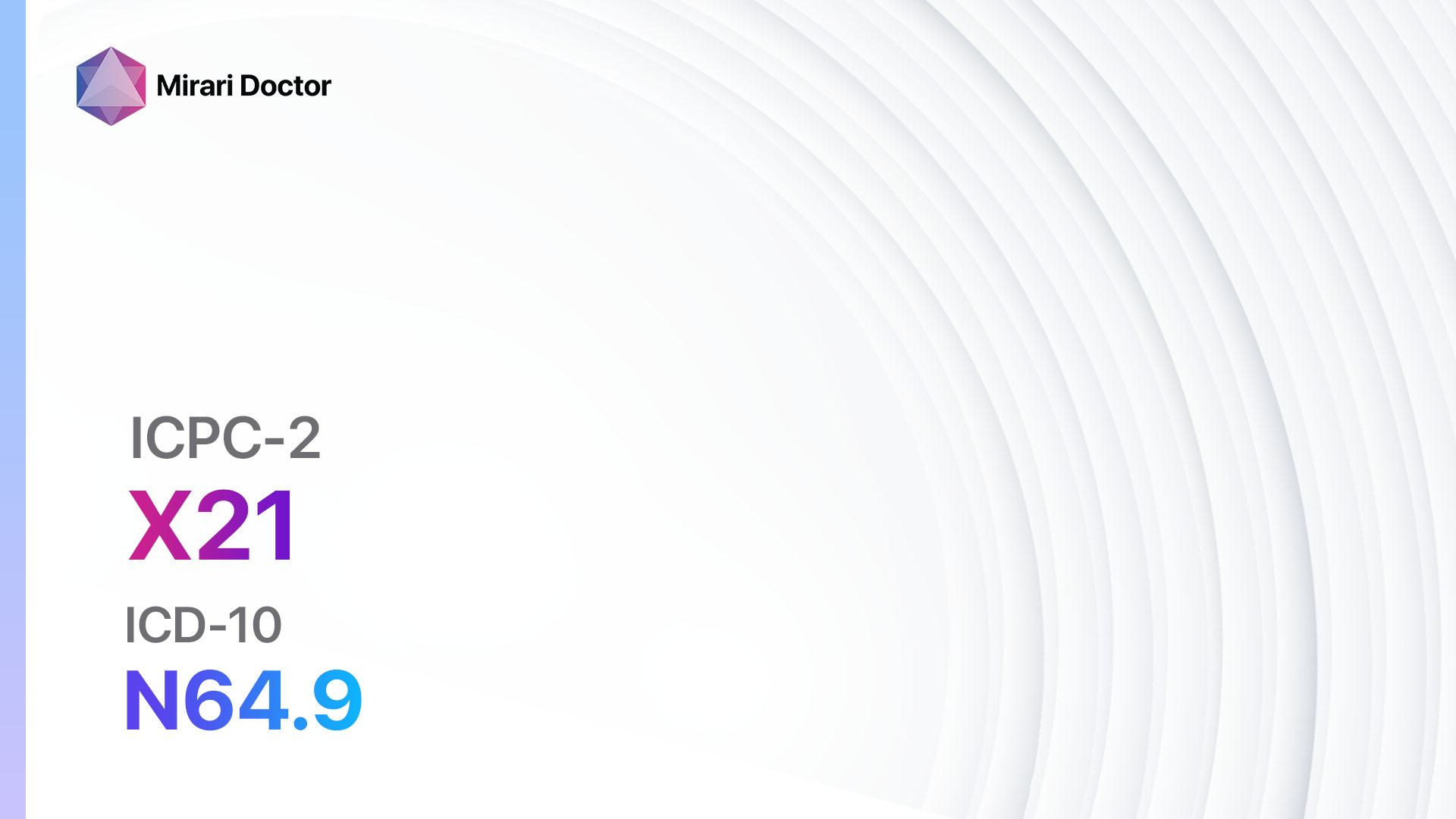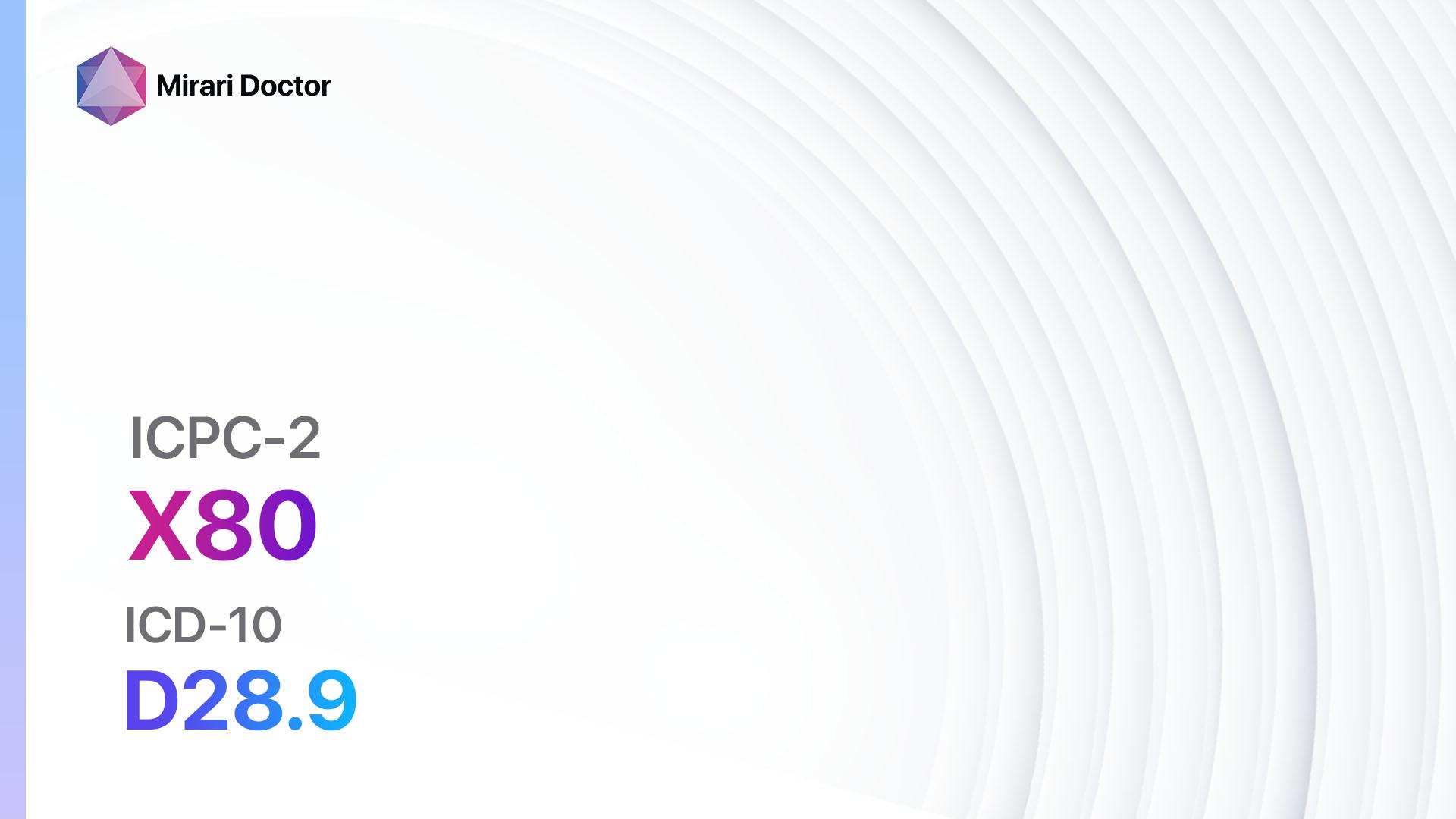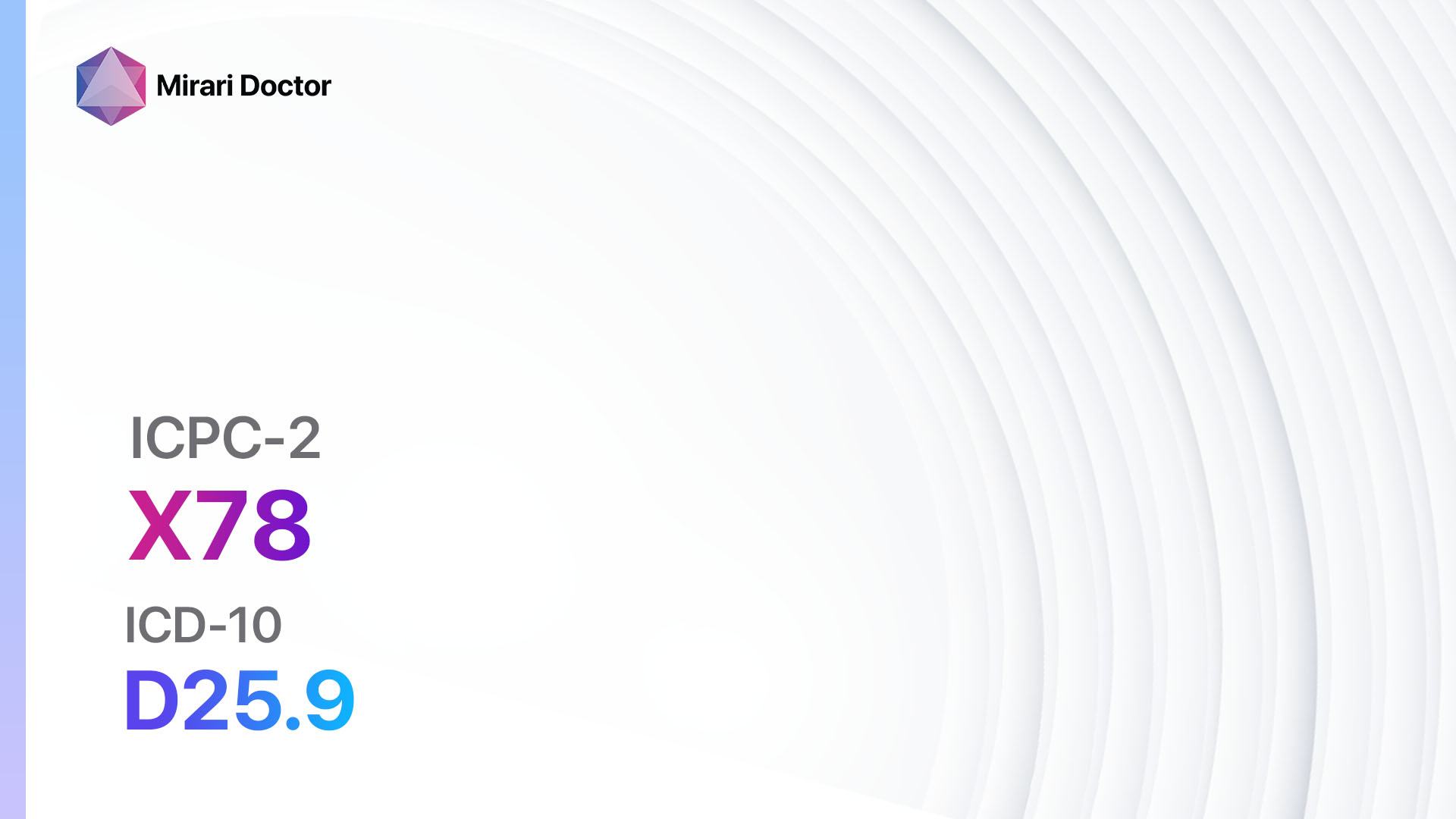
Introduction
Breast symptoms and complaints in females can be indicative of various conditions, ranging from benign to malignant. It is essential to evaluate these symptoms thoroughly to determine the underlying cause and provide appropriate management[1]. This guide aims to outline the diagnostic steps, possible interventions, and lifestyle modifications for breast symptoms and complaints in females.
Codes
- ICPC-2 Code: X21 Breast symptom/complaint female other
- ICD-10 Code: N64.9 Disorder of breast, unspecified
Symptoms
- Breast pain: Sensation of discomfort or tenderness in one or both breasts.
- Breast lump: Presence of a palpable mass or lump in the breast tissue.
- Nipple discharge: Spontaneous secretion of fluid from the nipple.
- Breast skin changes: Changes in the texture, color, or appearance of the breast skin.
- Breast swelling: Enlargement or swelling of the breast tissue.
- Breast asymmetry: Noticeable difference in size or shape between the two breasts[2].
Causes
- Fibrocystic changes: Benign changes in breast tissue, often associated with hormonal fluctuations.
- Breast cysts: Fluid-filled sacs within the breast tissue.
- Fibroadenomas: Noncancerous tumors composed of glandular and fibrous tissue.
- Intraductal papillomas: Benign growths within the milk ducts.
- Breast infection (mastitis): Inflammation of the breast tissue, usually caused by bacterial infection.
- Breast cancer: Malignant growth of cells in the breast tissue[3].
Diagnostic Steps
Medical History
- Gather information about the patient’s age, menstrual history, and hormonal status.
- Assess the presence of risk factors such as family history of breast cancer, previous breast biopsies, or exposure to radiation.
- Inquire about the duration, severity, and characteristics of the breast symptoms.
- Evaluate the presence of associated symptoms such as fever, nipple retraction, or skin changes[4]
Physical Examination
- Perform a thorough breast examination, including inspection, palpation, and assessment of lymph nodes.
- Note the presence of any palpable masses, tenderness, or skin changes.
- Assess the symmetry of the breasts and evaluate for any nipple discharge[5].
Laboratory Tests
- Complete blood count (CBC): To assess for signs of infection or anemia.
- Hormone levels: To evaluate hormonal imbalances that may contribute to breast symptoms.
- Tumor markers (e.g., CA 15-3, CA 27-29): To aid in the diagnosis and monitoring of breast cancer[6].
Diagnostic Imaging
- Mammography: X-ray imaging of the breast tissue to detect any abnormalities or masses.
- Ultrasound: Use of sound waves to visualize the breast tissue and assess the characteristics of any identified masses.
- Magnetic resonance imaging (MRI): Provides detailed images of the breast tissue, particularly useful in high-risk patients or to further evaluate suspicious findings[7].
Other Tests
- Breast biopsy: Removal of a sample of breast tissue for microscopic examination to determine the nature of any identified masses.
- Fine-needle aspiration (FNA): Use of a thin needle to extract fluid or cells from a breast lump for analysis.
- Ductography: Injection of contrast dye into the milk ducts followed by imaging to evaluate the presence of any abnormalities[8].
Follow-up and Patient Education
- Schedule follow-up appointments to monitor the progress of symptoms and response to treatment.
- Provide education on breast self-examination and the importance of regular mammograms for early detection of breast cancer.
- Discuss lifestyle modifications and interventions to manage symptoms and reduce the risk of complications[9][10].
Possible Interventions
Traditional Interventions
Medications:
Top 5 drugs for breast symptoms/complaints:
- Nonsteroidal anti-inflammatory drugs (NSAIDs) (e.g., Ibuprofen, Naproxen):
- Cost: Generic versions can be $3-$20/month.
- Contraindications: History of gastrointestinal bleeding, renal impairment.
- Side effects: Upset stomach, increased risk of bleeding.
- Severe side effects: Kidney damage, allergic reactions.
- Drug interactions: Anticoagulants, corticosteroids.
- Warning: Prolonged use may increase the risk of cardiovascular events.
- Hormonal therapy (e.g., Selective estrogen receptor modulators, Aromatase inhibitors):
- Cost: Varies depending on the specific medication.
- Contraindications: History of blood clots, endometrial cancer.
- Side effects: Hot flashes, vaginal dryness.
- Severe side effects: Increased risk of blood clots, stroke.
- Drug interactions: Tamoxifen interacts with certain antidepressants.
- Warning: Regular monitoring of bone density and lipid levels may be required.
- Antibiotics (e.g., Amoxicillin, Cephalexin):
- Cost: Generic versions can be $4-$20/month.
- Contraindications: Allergy to penicillin or cephalosporins.
- Side effects: Upset stomach, diarrhea.
- Severe side effects: Severe allergic reactions, Clostridium difficile infection.
- Drug interactions: Oral contraceptives, warfarin.
- Warning: Complete the full course of antibiotics as prescribed.
- Antifungal agents (e.g., Clotrimazole, Fluconazole):
- Cost: Generic versions can be $5-$30/month.
- Contraindications: Hypersensitivity to azole antifungals.
- Side effects: Skin irritation, rash.
- Severe side effects: Severe allergic reactions, liver damage.
- Drug interactions: Certain anticoagulants, statins.
- Warning: Use with caution in patients with liver or kidney disease.
- Analgesics (e.g., Acetaminophen, Tramadol):
- Cost: Generic versions can be $3-$20/month.
- Contraindications: Severe liver disease, history of drug addiction.
- Side effects: Upset stomach, drowsiness.
- Severe side effects: Liver damage, respiratory depression.
- Drug interactions: Alcohol, other medications containing acetaminophen.
- Warning: Avoid exceeding the recommended dosage.
Alternative Drugs:
- Evening primrose oil: May help alleviate breast pain and tenderness. Cost: $10-$30/month.
- Vitamin E: Some evidence suggests it may reduce breast pain. Cost: $5-$15/month.
- Bromocriptine: Can be used for breast pain associated with hormonal imbalances. Cost: $20-$50/month.
- Danazol: Reserved for severe cases of breast pain unresponsive to other treatments. Cost: $100-$300/month.
- Tamoxifen: Used in certain cases of breast pain associated with hormonal imbalances. Cost: $20-$100/month.
Surgical Procedures:
- Breast biopsy: Removal of a sample of breast tissue for further examination.
- Lumpectomy: Surgical removal of a breast lump or tumor while preserving the breast.
- Mastectomy: Surgical removal of the entire breast tissue.
- Breast reconstruction: Surgical procedure to restore the shape and appearance of the breast after mastectomy.
Alternative Interventions
- Acupuncture: May help alleviate breast pain and improve overall well-being. Cost: $60-$120 per session.
- Herbal supplements: Certain herbs like chasteberry or evening primrose oil may provide relief from breast symptoms. Cost: Varies depending on the specific supplement.
- Mind-body techniques: Practices such as yoga, meditation, or guided imagery may help manage stress and reduce breast pain. Cost: Varies depending on the specific practice.
- Physical therapy: Specific exercises and techniques may help alleviate breast pain and improve range of motion. Cost: $50-$150 per session.
- Breast massage: Gentle massage techniques may help improve lymphatic drainage and reduce breast pain. Cost: Varies depending on the practitioner.
Lifestyle Interventions
- Wearing a supportive bra: Properly fitted bras can provide support and alleviate breast discomfort. Cost: $20-$100.
- Dietary modifications: Avoiding caffeine, reducing salt intake, and consuming a balanced diet may help manage breast symptoms. Cost: Varies depending on individual food choices.
- Regular exercise: Engaging in regular physical activity can help reduce breast pain and improve overall well-being. Cost: Varies depending on the chosen exercise regimen.
- Stress management: Practicing relaxation techniques, such as deep breathing or mindfulness, can help reduce breast pain associated with stress. Cost: Varies depending on the chosen technique.
- Avoiding tobacco and alcohol: Limiting or avoiding tobacco and alcohol consumption may help alleviate breast symptoms. Cost: Varies depending on individual habits.
It is important to note that the cost ranges provided are approximate and may vary depending on the location and availability of the interventions. It is recommended to consult with healthcare professionals for personalized recommendations and cost estimates.
Mirari Cold Plasma Alternative Intervention
Understanding Mirari Cold Plasma
- Safe and Non-Invasive Treatment: Mirari Cold Plasma is a safe and non-invasive treatment option for various skin conditions. It does not require incisions, minimizing the risk of scarring, bleeding, or tissue damage.
- Efficient Extraction of Foreign Bodies: Mirari Cold Plasma facilitates the removal of foreign bodies from the skin by degrading and dissociating organic matter, allowing easier access and extraction.
- Pain Reduction and Comfort: Mirari Cold Plasma has a local analgesic effect, providing pain relief during the treatment, making it more comfortable for the patient.
- Reduced Risk of Infection: Mirari Cold Plasma has antimicrobial properties, effectively killing bacteria and reducing the risk of infection.
- Accelerated Healing and Minimal Scarring: Mirari Cold Plasma stimulates wound healing and tissue regeneration, reducing healing time and minimizing the formation of scars.
Mirari Cold Plasma Prescription
Video instructions for using Mirari Cold Plasma Device – X21 Breast symptom/complaint female other (ICD-10:N64.9)
| Mild | Moderate | Severe |
| Mode setting: 1 (Infection) Location: 0 (Localized) Morning: 15 minutes, Evening: 15 minutes |
Mode setting: 1 (Infection) Location: 0 (Localized) Morning: 30 minutes, Lunch: 30 minutes, Evening: 30 minutes |
Mode setting: 1 (Infection) Location: 0 (Localized) Morning: 30 minutes, Lunch: 30 minutes, Evening: 30 minutes |
| Mode setting: 2 (Wound Healing) Location: 0 (Localized) Morning: 15 minutes, Evening: 15 minutes |
Mode setting: 2 (Wound Healing) Location: 0 (Localized) Morning: 30 minutes, Lunch: 30 minutes, Evening: 30 minutes |
Mode setting: 2 (Wound Healing) Location: 0 (Localized) Morning: 30 minutes, Lunch: 30 minutes, Evening: 30 minutes |
| Mode setting: 3 (Antiviral Therapy) Location: 0 (Localized) Morning: 15 minutes, Evening: 15 minutes |
Mode setting: 3 (Antiviral Therapy) Location: 0 (Localized) Morning: 30 minutes, Lunch: 30 minutes, Evening: 30 minutes |
Mode setting: 3 (Antiviral Therapy) Location: 0 (Localized) Morning: 30 minutes, Lunch: 30 minutes, Evening: 30 minutes |
| Mode setting: 7 (Immunotherapy) Location: 1 (Sacrum) Morning: 15 minutes, Evening: 15 minutes |
Mode setting: 7 (Immunotherapy) Location: 1 (Sacrum) Morning: 30 minutes, Lunch: 30 minutes, Evening: 30 minutes |
Mode setting: 7 (Immunotherapy) Location: 1 (Sacrum) Morning: 30 minutes, Lunch: 30 minutes, Evening: 30 minutes |
| Total Morning: 60 minutes approx. $10 USD, Evening: 60 minutes approx. $10 USD |
Total Morning: 120 minutes approx. $20 USD, Lunch: 120 minutes approx. $20 USD, Evening: 120 minutes approx. $20 USD, |
Total Morning: 120 minutes approx. $20 USD, Lunch: 120 minutes approx. $20 USD, Evening: 120 minutes approx. $20 USD, |
| Usual treatment for 7-60 days approx. $140 USD – $1200 USD | Usual treatment for 6-8 weeks approx. $2,520 USD – $3,360 USD |
Usual treatment for 3-6 months approx. $5,400 USD – $10,800 USD
|
 |
|
Use the Mirari Cold Plasma device to treat Breast symptom/complt. female other effectively.
WARNING: MIRARI COLD PLASMA IS DESIGNED FOR THE HUMAN BODY WITHOUT ANY ARTIFICIAL OR THIRD PARTY PRODUCTS. USE OF OTHER PRODUCTS IN COMBINATION WITH MIRARI COLD PLASMA MAY CAUSE UNPREDICTABLE EFFECTS, HARM OR INJURY. PLEASE CONSULT A MEDICAL PROFESSIONAL BEFORE COMBINING ANY OTHER PRODUCTS WITH USE OF MIRARI.
Step 1: Cleanse the Skin
- Start by cleaning the affected area of the skin with a gentle cleanser or mild soap and water. Gently pat the area dry with a clean towel.
Step 2: Prepare the Mirari Cold Plasma device
- Ensure that the Mirari Cold Plasma device is fully charged or has fresh batteries as per the manufacturer’s instructions. Make sure the device is clean and in good working condition.
- Switch on the Mirari device using the power button or by following the specific instructions provided with the device.
- Some Mirari devices may have adjustable settings for intensity or treatment duration. Follow the manufacturer’s instructions to select the appropriate settings based on your needs and the recommended guidelines.
Step 3: Apply the Device
- Place the Mirari device in direct contact with the affected area of the skin. Gently glide or hold the device over the skin surface, ensuring even coverage of the area experiencing.
- Slowly move the Mirari device in a circular motion or follow a specific pattern as indicated in the user manual. This helps ensure thorough treatment coverage.
Step 4: Monitor and Assess:
- Keep track of your progress and evaluate the effectiveness of the Mirari device in managing your Breast symptom/complt. female other. If you have any concerns or notice any adverse reactions, consult with your health care professional.
Note
This guide is for informational purposes only and should not replace the advice of a medical professional. Always consult with your healthcare provider or a qualified medical professional for personal advice, diagnosis, or treatment. Do not solely rely on the information presented here for decisions about your health. Use of this information is at your own risk. The authors of this guide, nor any associated entities or platforms, are not responsible for any potential adverse effects or outcomes based on the content.
Mirari Cold Plasma System Disclaimer
- Purpose: The Mirari Cold Plasma System is a Class 2 medical device designed for use by trained healthcare professionals. It is registered for use in Thailand and Vietnam. It is not intended for use outside of these locations.
- Informational Use: The content and information provided with the device are for educational and informational purposes only. They are not a substitute for professional medical advice or care.
- Variable Outcomes: While the device is approved for specific uses, individual outcomes can differ. We do not assert or guarantee specific medical outcomes.
- Consultation: Prior to utilizing the device or making decisions based on its content, it is essential to consult with a Certified Mirari Tele-Therapist and your medical healthcare provider regarding specific protocols.
- Liability: By using this device, users are acknowledging and accepting all potential risks. Neither the manufacturer nor the distributor will be held accountable for any adverse reactions, injuries, or damages stemming from its use.
- Geographical Availability: This device has received approval for designated purposes by the Thai and Vietnam FDA. As of now, outside of Thailand and Vietnam, the Mirari Cold Plasma System is not available for purchase or use.
References
- Mayo Clinic. (2021). Breast pain – Diagnosis and treatment. Retrieved from https://www.mayoclinic.org/diseases-conditions/breast-pain/diagnosis-treatment/drc-20350426
- American Cancer Society. (2021). Breast Cancer Signs and Symptoms. Retrieved from https://www.cancer.org/cancer/breast-cancer/about/breast-cancer-signs-and-symptoms.html
- National Breast Cancer Foundation. (2021). Breast Cancer Causes. Retrieved from https://www.nationalbreastcancer.org/breast-cancer-causes
- American College of Obstetricians and Gynecologists. (2020). Benign Breast Problems and Conditions. Retrieved from https://www.acog.org/womens-health/faqs/benign-breast-problems-and-conditions
- National Comprehensive Cancer Network. (2021). NCCN Guidelines for Patients: Breast Cancer Screening and Diagnosis. Retrieved from https://www.nccn.org/patients/guidelines/content/PDF/breast-screening-patient.pdf
- American Society of Clinical Oncology. (2021). Breast Cancer: Diagnosis. Retrieved from https://www.cancer.net/cancer-types/breast-cancer/diagnosis
- Radiological Society of North America. (2021). Breast Cancer Screening. Retrieved from https://www.radiologyinfo.org/en/info/screening-breast
- American Cancer Society. (2021). Breast Biopsy. Retrieved from https://www.cancer.org/cancer/breast-cancer/screening-tests-and-early-detection/breast-biopsy.html
- Breastcancer.org. (2021). Breast Self-Exam. Retrieved from https://www.breastcancer.org/symptoms/testing/types/self_exam
- Centers for Disease Control and Prevention. (2021). What Can I Do to Reduce My Risk of Breast Cancer? Retrieved from https://www.cdc.gov/cancer/breast/basic_info/prevention.htm
Related articles
Made in USA




























